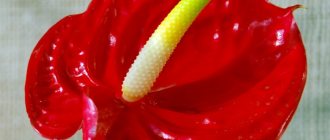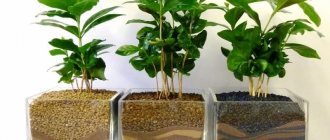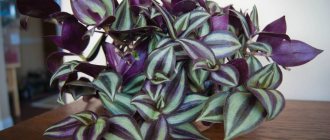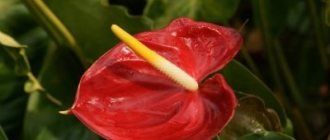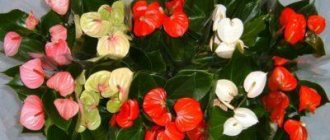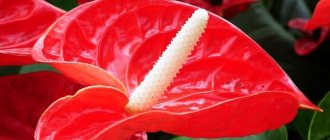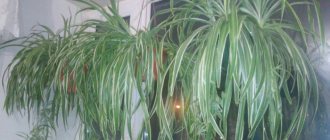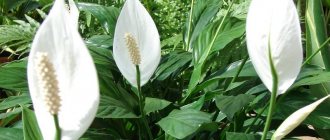Plant mix is new in the flower business. Knowing some of the secrets of floristry and floriculture, everyone can acquire a unique specimen of flora that will decorate and enliven any interior. But, like any living creature, it needs care and attention.
Due to inexperience, sellers in flower shops can stick the name “Plant mix” on any small or unfamiliar plant. But this is fundamentally wrong, because Plant mix translated from English means “Mixture of plants”. That is, a single specimen cannot bear such a name, with the exception of representatives that combine the characteristics of different varieties of the genus. But in this case they bear the name of the genus with the addition “mix”. For example, Dracaena mix or Anthurium mix.
Plant mix - what is it?
Plant mix is a miniature garden of several young plants of the same size, planted in separate identical pots. All specimens are collected on one decorative pallet or in a box and represent a unique colorful composition.
You can often find such compositions planted in one container. This could be an aquarium, terrarium, decorative shells or caves. To create such compositions, several varieties of plants of the same species are selected. Their foliage can be different colors, have variegated, intricate patterns, and they can bloom in different shades or at different times. The most common compositions are those made up of cacti, ficus and succulents, which do not have a fast growth rate.
To create a Plant Mix, plants with similar conditions and appearance can be selected.
One such set can include up to 25 representatives of indoor flowers. Typically, all of them are undemanding in care, require moderate watering and are well adapted for living in apartment conditions.
Many flowers in Plant Mix not only have a spectacular appearance, but also provide benefits to humans. Dieffenbachia, spathiphyllum, ivy, palm and fern plants release substances into the environment that can purify the air from fumes from household chemicals, tobacco smoke and other harmful substances, which has a positive effect on the health of households. They are also able to humidify too dry air. Dracaenas, ficuses, cacti and succulents resist radiation well from the use of office equipment and computers.
Basically, Plant mix, consisting of different plants, prefers moderate watering and periodic spraying in the hot season. They should be placed in well-lit rooms, avoiding exposure to direct sunlight. In spring and summer, plants should be provided with a temperature within 20-23 degrees. And in autumn and winter - no lower than 15 degrees. Also, in winter, watering and fertilizing should be reduced, because most plants enter a dormant period.
Beneficial features
How to care for aloe so that the flower grows well
In European countries, where this new trend came to us, plant mix sets are positioned as unpretentious living interior elements that carry not only aesthetic value, but also undeniable benefits. During the process of photosynthesis, flowers release oxygen into the air and absorb carbon dioxide and toxic substances. Leaf plates continuously evaporate moisture, reducing the dryness of the air. Some species secrete phytoncides that have a beneficial effect on human health.
Plant mix of succulents
There is an opinion that some plants absorb radiation from household appliances; it is not without reason that compositions of cacti are often placed near computers. This arrangement is only advisable if the table is located near the window, otherwise the cacti will stretch out from the lack of light and quickly lose their attractive appearance.
“Plant Mix” will decorate any room, be it an office, a public institution or a home. Properly selected species that do not require special care will create comfort and refreshment, and are also suitable as a gift: maintaining a mini-garden is simple and within the power of a novice gardener.
Features of plant mix flower care
Since there is a wide variety of indoor flowers combined in Plant mix, it is impossible to give specific advice on caring for them. But florists and experienced flower growers advise adhering to standard rules of agricultural technology.
- Watering in the summer. Almost all flowers like moderate watering and it is better to underwater them than to overwater them. The best option is to irrigate when the top layer of soil dries out. If it is established that the composition is made up of moisture-loving plants, then additionally regular spraying is carried out, which helps not only to maintain the level of humidity, but also to free the leaves from contaminants. For watering and spraying, you need to use clean, settled water at room temperature. The frequency of watering will depend on the genus of the Plant Mix plants.
- The soil. Since Plant mixes are made up of plants with similar requirements or from different varieties of the same genus, choosing a suitable soil mixture is not difficult. You just need to figure out what composition of soil is needed for a specific set of colors.
- Fertilizer application. It is customary to feed plants during the period of active growth and development - twice a month in spring and summer. You can use complex mineral fertilizers for decorative foliage or flowering indoor flowers. Alternating mineral and organic mixtures is also acceptable.
Watering in winter. In winter, watering is reduced because the flowers enter a dormant period and regain strength for the spring set of green mass or flowering. Also, the temperature in winter is much lower than in summer, so moisture evaporates longer, which means the soil should be irrigated less intensively.
All deviations from the general care scheme will depend on what genus or species the composition belongs to.
How to transplant flowers correctly
Plant mix is usually composed of young, slow-growing flowers. Plants should not be replanted immediately after purchase - they need to get used to the new conditions. Containers for flowers should be taken of the same size and compatible colors so as not to disturb the composition and maintain the decorative nature of the set.
Read also Shelter of chrysanthemums for the winter in Belarus
The procedure is standard:
- in each pot you need to lay a layer of drainage, which consists of crushed stone, pebbles, fragments of ceramics or expanded clay
- Nutritious soil is placed on the drainage layer, taking into account the size of the roots
- carefully place the plant in the ground, straightening its roots, and add the missing soil
- the final stage is abundant watering
Plant mix compositions began to spread from Europe and it is not customary to replant them there. But it is known that purchased plants do not live long without replanting. Therefore, everyone should spend a minimum of effort in order to preserve the decorative composition for a long time.
Methods of propagation and transplantation
Basically, Plant mix includes young flowers. But, if they are not replanted in Europe, then here it is still worth finding new pots for them. Otherwise, the flowers may simply die. They are purchased in shipping pots and the soil is only peat, and the flowers need a more varied composition.
If the place where the mix was purchased was cool enough, then the plants may experience stress in indoor conditions. It is recommended to give them some time to get used to the new place, and then transplant them. If the temperature regime is identical, then the transplant can be carried out immediately.
Before starting the replanting process, you need to clearly know what species and variety the plant belongs to.
And only then proceed to transplantation.
- Observe the decorativeness provided at the beginning, and purchase new flowerpots that are also the same or at least in the same style.
- Since in a mix all the plants are usually of the same genus, it is enough to know the type or variety of one. In accordance with this, purchase a soil mixture at the flower shop that will suit all the flowers in the set.
- As in most cases when replanting ornamental plants, here it is necessary to place a layer of drainage at the bottom of each pot. It is not recommended to use expanded clay, which introduces acidity into the soil. Crushed stone works well.
- Next, carefully fill in the purchased soil mixture. You then need to put the flower in a flowerpot and compact the soil a little.
- After planting, it is recommended to moisten the soil abundantly.
Plants can only be propagated by cuttings. To do this, you just need to carefully cut off the shoot a little below the node. It is recommended to disinfect the cut area. To do this, activated carbon must be crushed into fine crumbs and processed into sections. This will protect your plants from infections.
The length of the cutting should not exceed 15 cm. Before planting, it should be dipped in a phytohormone solution for a few seconds. Then plant the shoot in the ground. There is no need to cover the top with film.
Possible problems during cultivation
The most common problems when cultivating Plant Mix kits are damage by diseases and pests. Diseases develop due to non-compliance with agricultural practices and can be fungal or viral. The danger of diseases lies in the fact that if one plant becomes infected, the entire mini-garden will soon become ill. Therefore, you should be careful about care and follow the norm in everything.
The most common disease is black rot, which develops with excessive watering and first affects the roots of plants, and then the above-ground part.
To save the flowers, they need to be replanted with a complete replacement of the soil, treating the roots with a manganese solution. The plants themselves need to be treated with fungicides and watering reduced.
Plants can be attacked by different pests, it all depends on the types of plants in the set. For example, aphids often attack, but if the composition consists of conifers or palm trees, then this parasite will bypass them. Most often you can find:
- Aphids are small, immobile insects that envelop leaves and stems with sticky webs and feed on plant sap.
- Scale insects are small winged insects.
- Thripsov.
- Spider mites, whose activity leads to curling and drying of leaves. They are distinguished by the rapidity of spread. Parasites must be removed manually using a cotton pad soaked in alcohol.
If signs of infection are detected, the flowers should be isolated from the rest, because this parasite multiplies very quickly. If the infection is minor, remove all damaged parts of the plant and treat with insecticides. As a preventive measure, all other plants should be sprayed with a soap solution.
A plant mix of plants with smooth and dense leaves, succulents and cacti are the most resistant to diseases and pests, so they will not cause any problems.
At first, Plant mixes were created to decorate offices and study rooms. They were small in size and could easily be placed on the corner of a table or on a windowsill. But flower growers fell in love with the compositions and began to appear more and more often in houses and apartments. They impress with their ease of care and spectacular appearance, which is why they are very popular. There are also outdoor kits that can be used to decorate patios or outdoor verandas. And their mobility makes it easy to winter in a warm room.
More information can be found in the video:
Both amateur gardeners and beginners can grow a plant mix flower at home without any problems (translated from English as “a mixture of plants”). This species appeared relatively recently on flower markets, but despite this, it managed to interest many flower lovers.
The new product in question is, first of all, a living organism that needs constant care and attention. Knowing how to properly care for a plant mix flower and taking into account the recommendations of experts, all flower growers, without exception, will be able to grow a magnificent specimen at home that will decorate any interior.
What does dipladenia look like?
The plant is endowed with leathery emerald oval leaves with pointed ends. They are attached to long curly stems growing up the wall. The length of Dipladenia (Mandevilla) reaches 4 m. At home, the plant can be grown as an indoor vine or a compact bush. The lush foliage is decorated with funnel-shaped bright flowers with five petals (about 12 cm in diameter). They come in raspberry, red, pink, and white shades. The plant blooms generously and brightly from spring to late autumn, producing about 80 buds that stay on the branches for 10 days.
Rules of care
Let's consider simple recommendations provided by experts that will help raise a healthy and beautiful green pet:
1. Following watering rules and maintaining optimal humidity is, of course, important for green friends. But giving general advice on these issues regarding the plant mix flower is not so easy. The fact is that the houseplant in question is not a single specimen of a representative of the flora, but several at once. The name itself speaks for itself. But knowing that this new product usually contains plants that are easy to care for, experts recommend not to overdo it with watering. The fact is that excess moisture is considered more destructive for such unusual green pets. Ideally, water the planting only after the top layer of soil has completely dried. 2. It is equally important to follow the rules of watering, taking into account the season. Since in the summer, almost all representatives of the flora are more demanding of moisture, and in the winter, when the dormant period begins, the plants almost do not need watering at all. You should use only settled water at room temperature. In the summer heat, it will not be superfluous to spray with a spray bottle, especially moisture-loving varieties. 3. It is important to take care of the correct location for the flower so that direct sunlight cannot damage the delicate leaves. Ideally, place the plant on a windowsill facing west or east. Temperature conditions are also important for the normal growth and development of indoor plants. The optimal summer temperature is considered to be +20…+23 degrees; in winter, the temperature should not fall below +16 degrees. 4. Soil for replanting and fertilizing should be introduced from the beginning of spring to the end of summer 2 times a month. In this case, you need to choose taking into account the varieties that make up the flower arrangement. It is best to address this question to a sales consultant working in the store. Fertilizers are applied to the soil of both organic and mineral types. In winter, the green pet does not need fertilizer at all. 5. Every day you need to monitor the health of your garden on the windowsill in order to promptly help the plants cope with pests. Most often, indoor flowers are damaged by aphids, scale insects, spider mites and black rot. Pest control measures depend on what kind of parasite has begun to annoy the flower. For example, if a scale insect is noticed on a plant, you will need to use an insecticide to thoroughly spray the leaves, trunk and even the soil. If the plant is damaged by black rot, a fungicide is used for treatment, watering is immediately reduced and the plant is transplanted into another soil.
Before treating flowers with insecticides, you need to take them out into the fresh air and put on special protective gloves. If treatment is required to be carried out in winter, the procedure should be performed in a well-ventilated area.
Diseases and pests
The most characteristic sign of the appearance of scale insects is the presence of black dots on the leaves. To combat scale insects, organophosphorus should be used. Spider mites can only appear in an excessively dry room.
If you ignore moisture control and forget about spraying the flower, the mite can harm it. A characteristic feature of this pest is the presence of cobwebs on shoots and leaves. Insecticides "Derris" or will help in the fight against it.
In addition to pests, the plant can be susceptible to various diseases due to improper care or unsuitable indoor microclimate.
Many flower lovers have repeatedly wondered how realistic it is to maintain and breed these wonderful and beautiful inhabitants at home. At first glance, it may seem that the rose bush is an extremely difficult plant to grow at home. Let's try to figure out how to grow it at home.
This plant is native to the tropical forests of the Southeast Asian continent. In the European part, they became known at the beginning of 1810
, during their arrival from China. Mixed rose belongs to the Rosaceae family and belongs to the genus of miniature plants.
Classification groups and varieties of roses
There are two main types of this plant for cultivation:
- Decorative pots
are usually temporary. More often used to form temporary compositions. After flowering, wilting occurs. - Flowering decorative indoor plants
- grow at home, are evergreen, often bloom, often all year round.
There are several most popular types:
- Patio mix
- differ from others in the largest size of both the flowers and the plant itself, but are short-growing (height no more than 50 cm). The period of appearance of flowers is quite long, the color variations are varied. - Turbo
- also bloom for quite a long time. They are distinguished by a rich range of colors and large buds. - Cornadas
are the smallest plants. A characteristic feature is short stature and small bud size. - Parade mix
is the most popular among all home roses. Has the best adaptation to living in an apartment. Flowering occurs very often. - Mini mix
- these include a large category of plants. It has a low stem part, flowers are usually medium or small in size. Well suited for indoor breeding.
Step-by-step transplant
To create mixes, representatives of the flora that are characterized by slow growth are most often used. After purchasing a green arrangement, you should not immediately replant it in a new flower pot. It is important to let the plants get used to the new growing conditions.
Read also Terracing of slopes is rational use of natural resources
The soil mixture must be selected taking into account the varieties that make up the composition. For example, if succulent varieties were used to create the mix, then soil must be purchased specifically for succulent plants.
The transplant is carried out in the following sequence:
• a drainage layer, for example, made of crushed stone, is poured onto the bottom; • a suitable soil mixture is poured over the drainage; • carefully move the plants into a new container, try not to damage the root system.
The top layer is lightly compacted by hand and watered generously with settled water.
It is worth noting that in its homeland, in European countries, it is not customary to replant an acquired plant mix. However, experienced gardeners are well aware that if the plant is not replanted in a timely manner, it will be able to please the eye for a negligibly short period of time.
Having seen for sale a separate specimen of a representative of the flora, on the pot of which there is the inscription “Plant mix”, you need to understand that the inscription is not the name of the plant, but simply the sellers decided to sell the only specimen from the composition.
Plant Mix is a new product on the flower market; like any living organism, it needs care and attention. Comfortable conditions and knowledge of the little tricks of floriculture will allow you to get a specimen that will be the pride of the owners and an excellent decoration for the house.
Mix care. The incomparable dracaena palm mix as a decoration for your home
A plant that combines different characteristics of its species is labeled “mix”.
There are Kalanchoemix, hibiscus mix, cactus mix and other varieties. Dracaena mix is no exception. It was possible to obtain such a flower by crossing different types of dracaenas
.
External signs may differ significantly among representatives of the mix series. The leaves can be either wide or narrow and have longitudinal stripes. The color also varies from yellow to red-brown.
Home care requirements
Let's look at the basics of how to care for an unusual pet.
Humidity and watering
In summer
It is impossible to give general recommendations for watering , since the mix may consist of different plants. It should be noted that almost all of them are usually easy to maintain and excess moisture is much more harmful for them than insufficient watering. Water after the top layer of soil dries out.
For irrigation, use clean, settled water.
Water with settled water and be sure to find out what specific plants your home flower bed consists of. This will help you avoid mistakes in creating optimal conditions for flowers.
in winter
In winter, watering is reduced. This happens for two reasons:
| 1 | Because a period of rest . |
To give them a rest and gain strength for spring growth and flowering, water much less frequently than in summer.
Temperature and lighting
Almost any option will feel good if it is not exposed to direct sunlight and at the same time the flowers have enough diffused sunlight. Flowers for a set are usually selected so that they develop well in the temperature range from +18 to +23°C in summer, and +15°C and above in winter.
Like any indoor flowers, the components of the set do not like direct sunlight
Soil and fertilizers
Since this is a collection of similar varieties or one species, choosing a soil mixture and fertilizer for it is not difficult. You just need to find out which fertilizers and soil mixture are suitable for your flowers.
Diseases and pests
This also depends on the composition of the garden on the windowsill. For example, aphids attack very often, but if your mix consists of several varieties of dwarf palms, then the aphids will not like it. Others are quite often affected:
- Aphid . Small, motionless insects are clearly visible. It is necessary to isolate the pet and carefully examine it. If the aphid has not yet managed to capture the flower and only a few leaves are affected, then they must be torn off and burned or carefully packaged and thrown away.
The flower itself can be treated with a solution of laundry or tar soap. Dissolve 30 or 10 g of soap in a liter of water and spray your pet. A suitable insecticide can also be used for this purpose.
- Shield . Small winged insects feeding on the sap of leaves. An insecticide can be used for treatment.
- Thrips . Treated with insecticides.
- Spider mite . A sticky web appears on the stem, the leaves dry out and curl. The affected areas must be treated with a cotton pad moistened with an alcohol solution and then rinsed with water.
- Black rot . Usually occurs when overwatering. Black spots appear on the leaves, the stem, leaves and roots begin to rot and the plant dies. If a disease is detected, it is necessary to treat with a fungicide and reduce watering.
Treatment with insecticides is carried out wearing protective gloves in the open air or in a well-ventilated area.
Transplantation step by step
Mixes are usually made up of young plants that grow slowly. After you have found out the species composition of your mix and brought it from the store, you need to give some time for the flowers to get used to the new conditions.
Read also: Is it possible to whiten with chalk over lime?
When replanting, do not forget to choose the right flowerpots so that the composition is not disturbed
Since the plants in the mix are planted in identical pots , when replanting you should pay attention to this and select the pots accordingly. This will preserve the decorative nature of the set.
The soil is selected individually for each Plant Mix. If your set consists of succulents, then the soil must be appropriate.
Usually it includes plants that require a similar soil composition . Therefore, having learned what kind of soil one flower from the set needs, you can easily understand what the rest will need.
A drainage layer is poured onto the bottom of the pot, then a layer of suitable soil is placed, carefully, trying not to damage the roots, the plant is placed in a new pot, soil is added and watered.
To be fair, it should be noted that in Europe, where the new design solution came from, Plant Mixes are usually not replanted , but experienced flower growers know very well that without replanting the purchased plant will not please for very long.
What beneficial properties do they have?
Initially, Plant Mixes were created so that they could easily be placed on a table in an office, on a small window sill in an office, or on a shelf by a window. The plants included in the set perfectly purify the air, saturate it with oxygen and absorb harmful radiation from computers and other devices.
They do not require complicated maintenance, and not only perfectly decorate any room, but also allow you to breathe much more freely , protecting you from exhaust gases, plastic fumes when plastic windows are heated in the sun, and similar troubles.
How a flower blooms
Plant Mixes are usually made from plants that do not flower. Often consists of succulents, which are one of the most unpretentious plants.
When kept indoors, they all bloom very rarely. For example, aloe has cylindrical flowers on cone-shaped inflorescences . Depending on the variety, they can be orange, reddish or yellow-pink.
Aloe and succulents do not require special care, so they often end up in the same sets
Cacti usually bloom after 3-4 years of age. To achieve flowering, it is necessary to provide the cactus with a winter dormant period. Exist within the boundaries of no higher than +10-12°C and watering no more than once a month.
Agave blooms at the age of 10-30 years; after flowering, the plant, having devoted all its strength to it, usually dies. Agave usually blooms only in its natural habitat and then the inflorescences reach 1-2 meters in height and consist of small, inconspicuous flowers.
The inflorescence itself looks very beautiful.
Crassula , in order to ensure its flowering, the flower also needs a period of rest. It is necessary to completely stop watering for at least a month. At the same time, the leaves of the fat plant lose moisture and may even wrinkle.
Reproduction
The easiest way to propagate all succulents in Plant Mix is by cuttings. The cutting can be placed directly into the soil. It takes root quickly and does not need to be covered with film. The main thing is to let the cut of the selected cutting dry.
Cuttings are a recognized reliable method of flower propagation.
Similarly, these plants reproduce by leaf.
What is Plant Mix
Plant Mix (they may mistakenly be called Plantin) is a relatively new direction in interior design using indoor flowers. It is a combination of several plants similar in conditions of maintenance and appearance into one picturesque composition.
Usually these are small plants that do not bloom . All of them are planted in identical pots to enhance the decorative properties of the composition.
Sometimes plants of the same species are planted in the same pot. Then several varieties are combined. They can have different leaf colors or patterns on the leaf plates, thanks to which an amazing mix is created that can steal the most sophisticated interior.
Tillandsia species
About 400 species of exotics are known, but only a few of them are grown at home.
All known species are divided into 2 groups:
- ground, or potted - have a rigid stem and green leaves;
- epiphytic, or atmospheric - no stem, leaves are silvery, narrow and long.
Tillandsia blue or cyanea
The leaves are glossy and green. They grow 30–40 centimeters in length, and no more than two in width.
The bracts are pinkish, with blue flowers formed between them, which do not lose their decorative effect for 2.5 months.
Monocarpic variety.
Tillandsia Anita
This is a hybrid of the previous variety. It is especially popular due to its increased decorative effect. In the center of a rosette formed from narrow leaves, surrounded by pinkish bracts, there is a blue flower. Although it fades quickly, the bracts retain their bright color for a long time, and then begin to turn green.
Tillandsia usneiformes, or mossy
This is the most common epiphyte. Its branches hang down, reaching several meters in length. The branches bear silver thread-like leaves, one centimeter wide and five centimeters long. The plant is popularly called Old Man's Beard, as well as Spanish or Louisiana moss. Gray leaves turn green when wet.
Epiphyte flowers have a faded greenish or yellowish color, which is why they are not very attractive. But they emit a pleasant aroma.
Tillandsia tricolor
The leaves of the plant are green. They are thin and narrow, growing up to 20 centimeters in length.
Tillandsia got its name because of its multi-colored (red-yellow-light green) sepals. The flower is purple, has a long 7-centimeter stem. Often several spikelets are formed.
Tillandsia Flabellata
It is distinguished by bright orange-red bracts that have a tubular shape. They give the plant a special decorative effect. The flowers are purple.
Jellyfish head
An epiphyte whose leaves “look” in different directions, resembling a squid or jellyfish.
Similar names
Fittonia Mix
Fittonia is a native of South America. The plant belongs to the Acanthaceae family and is represented by only 10 species . The plants are distinguished by beautiful unusual leaves, which, depending on the species, can be green, white, red or lilac.
This allows you to plant 5-6 species in one flower pot and get a bright and unique interior decoration. It is this, and not a single plant, that is called Fittonia mix.
Plant Mix
Sets consisting of several different plants that are similar in conditions of maintenance and create a unique composition. Small flower pots usually about 10 cm in diameter , are placed on a special tray or in a decorative box and represent a miniature garden.
Dracaena palm mix
Dracaena is often confused with palm, but it is a completely different plant. Varieties of dracaena, which combine the decorative features of several of its species, began to appear in gardening and flower shops with an unusual name, dracaena mix.
Caring for dracaena mix is no different from caring for regular dracaena.
Dracaena mix
This is the correct name for the dracaena that was described above. It should be remembered that considering dracaena a palm tree is a big mistake. Optimal conditions for keeping a palm tree are absolutely not suitable for dracaena. If you do not take this into account, you can destroy the plant .
The abundance of plants in its composition allows you to get acquainted with different species and get a large collection of plants at once, which, despite their diversity, are similar in care. At first, this is very convenient, it allows you to perfectly decorate the interior and not be disappointed in your chosen hobby.
| 2 | Due to the decrease in temperature, moisture evaporates much more slowly. Spraying is not carried out in winter |
Requirements for soil, temperature
Regardless of which variety and which method of growing alstroemeria we choose, we need to provide it with the right conditions so that it can bloom profusely all summer.
To grow alstroemeria, you need to choose a warm, very bright position, protected from direct sun. You also need to choose a place protected from the winds. The plant does not like low temperatures or too high.
Ideally a bright place with diffused light. The plant does not like southern balconies and window sills. It also does not like shadows; due to a small amount of light, flowering becomes less abundant. In hot summers, a little coolness is needed, which promotes long-term flowering, so eastern or western exposure is preferable.
A place where the sun illuminates the plant in the morning until 10-11 am and in the evening after 6 pm is ideal.
Alstroemeria needs soil with the following characteristics:
- fertile;
- humus;
- permeable;
- constantly slightly damp;
- with a slightly acidic pH (5.5-6.5).
